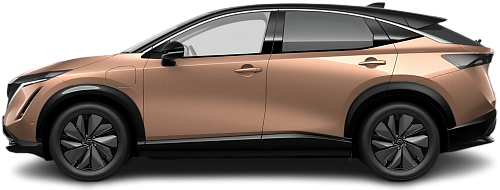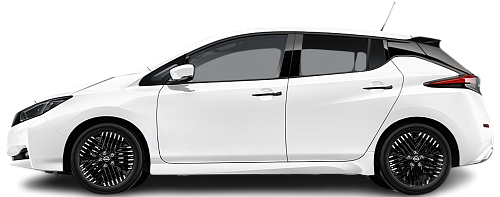Nissan Ariya 63 kWh FWD vs Leaf 40 kWh
Struggling to Decide? Let AI Help!
Your AI Summary Is Ready!
General Info
Both vehicles are currently in production and can be purchased new. The Nissan Ariya 63 kWh FWD (2021-…) has a starting price of €43490, compared to the Nissan Leaf 40 kWh (2022-…), which starts at €35900.
The Nissan Ariya 63 kWh FWD (2021-…) is a SUV, whereas the Nissan Leaf 40 kWh (2022-…) is a Hatchback.
| Property | Nissan Ariya 63 kWh FWD | Nissan Leaf 40 kWh |
|---|---|---|
| Years of Production | 2021-… | 2022-… |
| Current Status | Produced | Produced |
| Country of Manufacture | Japan, China | Japan, UK, USA |
| Body Style | SUV | Hatchback |
| Market Availability | EU, USA | EU, USA |
| Price Europe (New) | €43490 | €35900 |
| Price Europe (Used) | €30990 | €15890 |
| GCC Score | 5.6 | 4.8 |
Range and Efficiency
While the Nissan Ariya 63 kWh FWD (2021-…) offers a longer real-world range and a bigger battery, it is less energy-efficient than the Nissan Leaf 40 kWh (2022-…).
| Property | Nissan Ariya 63 kWh FWD | Nissan Leaf 40 kWh |
|---|---|---|
| Range (EPA) | 348 km | 240 km |
| Range (WLTP) | 404 km | 285 km |
| Range (GCC) | 332 km | 238 km |
| Battery Capacity (Nominal) | 66 kWh | 40 kWh |
| Battery Capacity (Usable) | 63 kWh | 39 kWh |
| Efficiency per 100 km | 19 kWh/100 km | 16.4 kWh/100 km |
| Efficiency per kWh | 5.27 km/kWh | 6.1 km/kWh |
| Range and Efficiency Score | 5.7 | 5.6 |
Charging
Both vehicles utilize a standard 400-volt architecture.
The Nissan Ariya 63 kWh FWD (2021-…) offers faster charging speeds at DC stations, reaching up to 130 kW, while the Nissan Leaf 40 kWh (2022-…) maxes out at 50 kW.
The Nissan Ariya 63 kWh FWD (2021-…) features a more powerful on-board charger, supporting a maximum AC charging power of 7.4 kW, whereas the Nissan Leaf 40 kWh (2022-…) is limited to 3.6 kW.
| Property | Nissan Ariya 63 kWh FWD | Nissan Leaf 40 kWh |
|---|---|---|
| Max Charging Power (AC) | 7.4 kW | 3.6 kW |
| Max Charging Power (DC) | 130 kW | 50 kW |
| Architecture | 400 V | 400 V |
| Charge Port | CCS Type 2 | CHAdeMO |
| Charging Score | 4.8 | 3.3 |
Performance
Both vehicles are front-wheel drive.
The Nissan Ariya 63 kWh FWD (2021-…) boasts greater motor power and accelerates faster from 0 to 100 km/h.
| Property | Nissan Ariya 63 kWh FWD | Nissan Leaf 40 kWh |
|---|---|---|
| Drive Type | FWD | FWD |
| Motor Type | 1 motor: EESM | 1 motor: PMSM |
| Motor Power (kW) | 160 kW | 110 kW |
| Motor Power (hp) | 215 hp | 148 hp |
| Motor Torque | 300 Nm | 320 Nm |
| 0-100 km/h | 7.5 s | 7.9 s |
| Top Speed | 160 km/h | 144 km/h |
| Performance Score | 3.5 | 3.1 |
Dimensions
The Nissan Ariya 63 kWh FWD (2021-…) is longer, wider, and taller.
The Nissan Ariya 63 kWh FWD (2021-…) boasts a more extended wheelbase.
| Property | Nissan Ariya 63 kWh FWD | Nissan Leaf 40 kWh |
|---|---|---|
| Length | 4595 mm | 4490 mm |
| Width (with Mirrors) | 2172 mm | 2030 mm |
| Width (w/o Mirrors) | 1850 mm | 1788 mm |
| Height | 1660 mm | 1530 mm |
| Wheelbase | 2775 mm | 2700 mm |
Cargo and Towing
The Nissan Ariya 63 kWh FWD (2021-…) provides more cargo capacity, featuring both a larger trunk and more space with the rear seats folded.
Neither car is equipped with a frunk (front trunk).
The Nissan Ariya 63 kWh FWD (2021-…) has a towing capacity of up to 750 kg, whereas the Nissan Leaf 40 kWh (2022-…) is not officially rated for towing in the EU.
| Property | Nissan Ariya 63 kWh FWD | Nissan Leaf 40 kWh |
|---|---|---|
| Number of Seats | 5 | 5 |
| Curb Weight | 1980 kg | 1580 kg |
| Cargo Volume (Trunk) | 466 l | 435 l |
| Cargo Volume (Max) | 1350 l | 1176 l |
| Cargo Volume (Frunk) | - Cargo Volume (Frunk) | - Cargo Volume (Frunk) |
| Towing Capacity | 750 kg | - Towing Capacity |
| Cargo and Towing Score | 6.8 | 4.6 |




